Paper Menu >>
Journal Menu >>
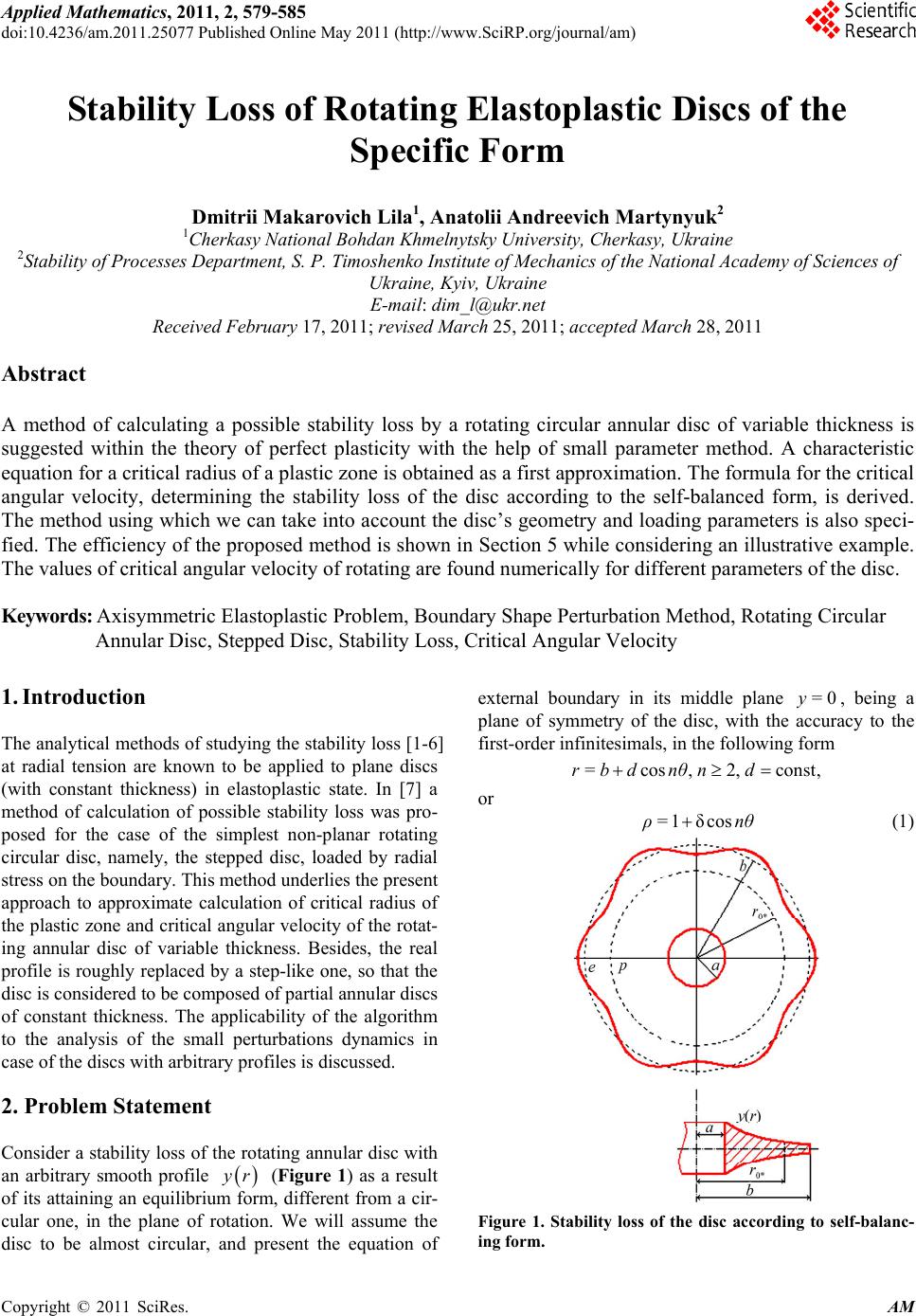 Applied Mathematics, 2011, 2, 579-585 doi:10.4236/am.2011.25077 Published Online May 2011 (http://www.SciRP.org/journal/am) Copyright © 2011 SciRes. AM Stability Loss of Rotating Elastoplastic Discs of the Specific Form Dmitrii Makarovich Lila1, Anatolii Andreevich Martynyuk2 1Cherkasy National Bohdan Khmelnytsky University, Cherkasy, Ukraine 2Stability of Processes Department, S. P. Timoshenko Institute of Mechanics of the National Academy of Sciences of Ukraine, Kyiv, Ukraine E-mail: dim_l@ukr.net Received February 17, 2011; revised March 25, 2011; accepted March 28, 2011 Abstract A method of calculating a possible stability loss by a rotating circular annular disc of variable thickness is suggested within the theory of perfect plasticity with the help of small parameter method. A characteristic equation for a critical radius of a plastic zone is obtained as a first approximation. The formula for the critical angular velocity, determining the stability loss of the disc according to the self-balanced form, is derived. The method using which we can take into account the disc’s geometry and loading parameters is also speci- fied. The efficiency of the proposed method is shown in Section 5 while considering an illustrative example. The values of critical angular velocity of rotating are found numerically for different parameters of the disc. Keywords: Axisymmetric Elastoplastic Problem, Boundary Shape Perturbation Method, Rotating Circular Annular Disc, Stepped Disc, Stability Loss, Critical Angular Velocity 1. Introduction The analytical methods of studying the stability loss [1-6] at radial tension are known to be applied to plane discs (with constant thickness) in elastoplastic state. In [7] a method of calculation of possible stability loss was pro- posed for the case of the simplest non-planar rotating circular disc, namely, the stepped disc, loaded by radial stress on the boundary. This method underlies the present approach to approximate calculation of critical radius of the plastic zone and critical angular velocity of the rotat- ing annular disc of variable thickness. Besides, the real profile is roughly replaced by a step-like one, so that the disc is considered to be composed of partial annular discs of constant thickness. The applicability of the algorithm to the analysis of the small perturbations dynamics in case of the discs with arbitrary profiles is discussed. 2. Problem Statement Consider a stability loss of the rotating annular disc with an arbitrary smooth profile y r (Figure 1) as a result of its attaining an equilibrium form, different from a cir- cular one, in the plane of rotation. We will assume the disc to be almost circular, and present the equation of external boundary in its middle plane 0 y = const, , being a plane of symmetry of the disc, with the accuracy to the first-order infinitesimals, in the following form =cos,2,rbd nθnd or =1 δcosρnθ (1) Figure 1. Stability loss of the disc according to self-balanc- ing form. 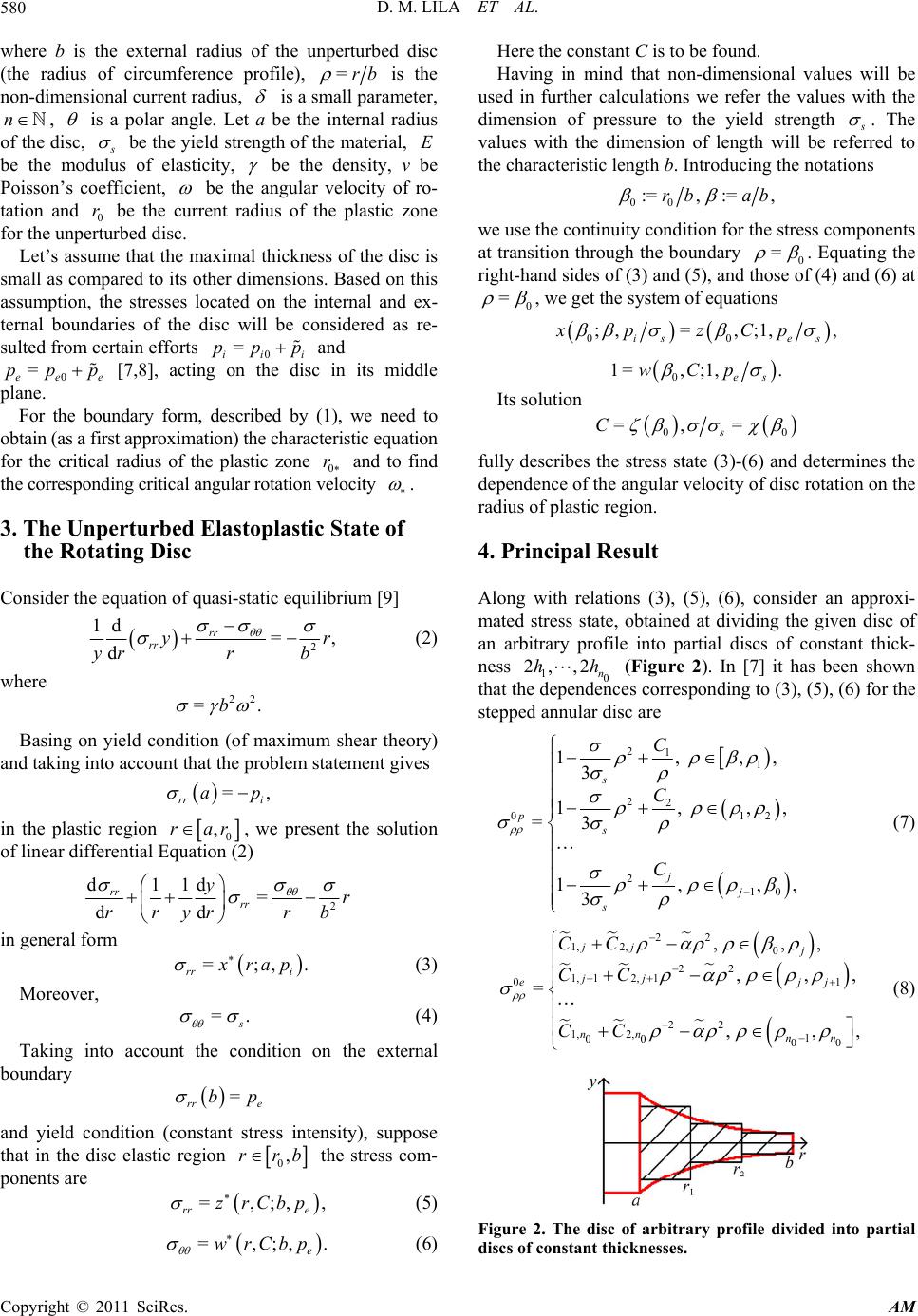 D. М. LILA ET AL. 580 where b is the external radius of the unperturbed disc (the radius of circumference profile), =r b is the non-dimensional current radius, is a small parameter, , n is a polar angle. Let a be the internal radius of the disc, s be the yield strength of the material, be the modulus of elasticity, E be the density, v be Poisson’s coefficient, be the angular velocity of ro- tation and 0 be the current radius of the plastic zone for the unperturbed disc. r Let’s assume that the maximal thickness of the disc is small as compared to its other dimensions. Based on this assumption, the stresses located on the internal and ex- ternal boundaries of the disc will be considered as re- sulted from certain efforts 0i and [7,8], acting on the disc in its middle plane. = ii pp p 0 = ee pp pe For the boundary form, described by (1), we need to obtain (as a first approximation) the characteristic equation for the critical radius of the plastic zone 0 and to find the corresponding critical angular rotation velocity r . 3. The Unperturbed Elastoplastic State of the Rotating Disc Consider the equation of quasi-static equilibrium [9] 2 1d = d rr rr y yrr b ,r (2) where 22 =.b Basing on yield condition (of maximum shear theory) and taking into account that the problem statement gives =, rr i ap in the plastic region 0 ,rar, we present the solution of linear differential Equation (2) 2 d11d = dd rr rr yr rryr r b in general form =;, rri . x rap (3) Moreover, =. s (4) Taking into account the condition on the external boundary = rr e bp and yield condition (constant stress intensity), suppose that in the disc elastic region 0,rrb the stress com- ponents are =,;, rr e zrCbp , (5) =,;, e wrCbp Here the constant C is to be found. Having in mind that non-dimensional values will be used in further calculations we refer the values with the dimension of pressure to the yield strength s . The values with the dimension of length will be referred to the characteristic length b. Introducing the notations 00 :=, :=,rb ab we use the continuity condition for the stress components at transition through the boundary 0 = . Equating the right-hand sides of (3) and (5), and those of (4) and (6) at 0 = , we get the system of equations 00 ;,= ,;1,, is es xp zCp 0 1=, ;1,. es wCp Its solution 00 =,= s C fully describes the stress state (3)-(6) and determines the dependence of the angular velocity of disc rotation on the radius of plastic region. 4. Principal Result Along with relations (3), (5), (6), consider an approxi- mated stress state, obtained at dividing the given disc of an arbitrary profile into partial discs of constant thick- ness 10 (Figure 2). In [7] it has been shown that the dependences corresponding to (3), (5), (6) for the stepped annular disc are 2, ,2 n hh 21 1 22 12 0 2 10 1,, 3 1,, =3 1, 3 s p s j j s C C C , , ,, (7) 22 1, 2,0 22 1, 12, 11 0 22 1, 2,1 00 00 ,,, ,, = ,, jj j jj jj e nn nn CC CC CC , , (8) Figure 2. The disc of arbitrary profile divided into partial discs of constant thicknesses. . (6) Copyright © 2011 SciRes. AM 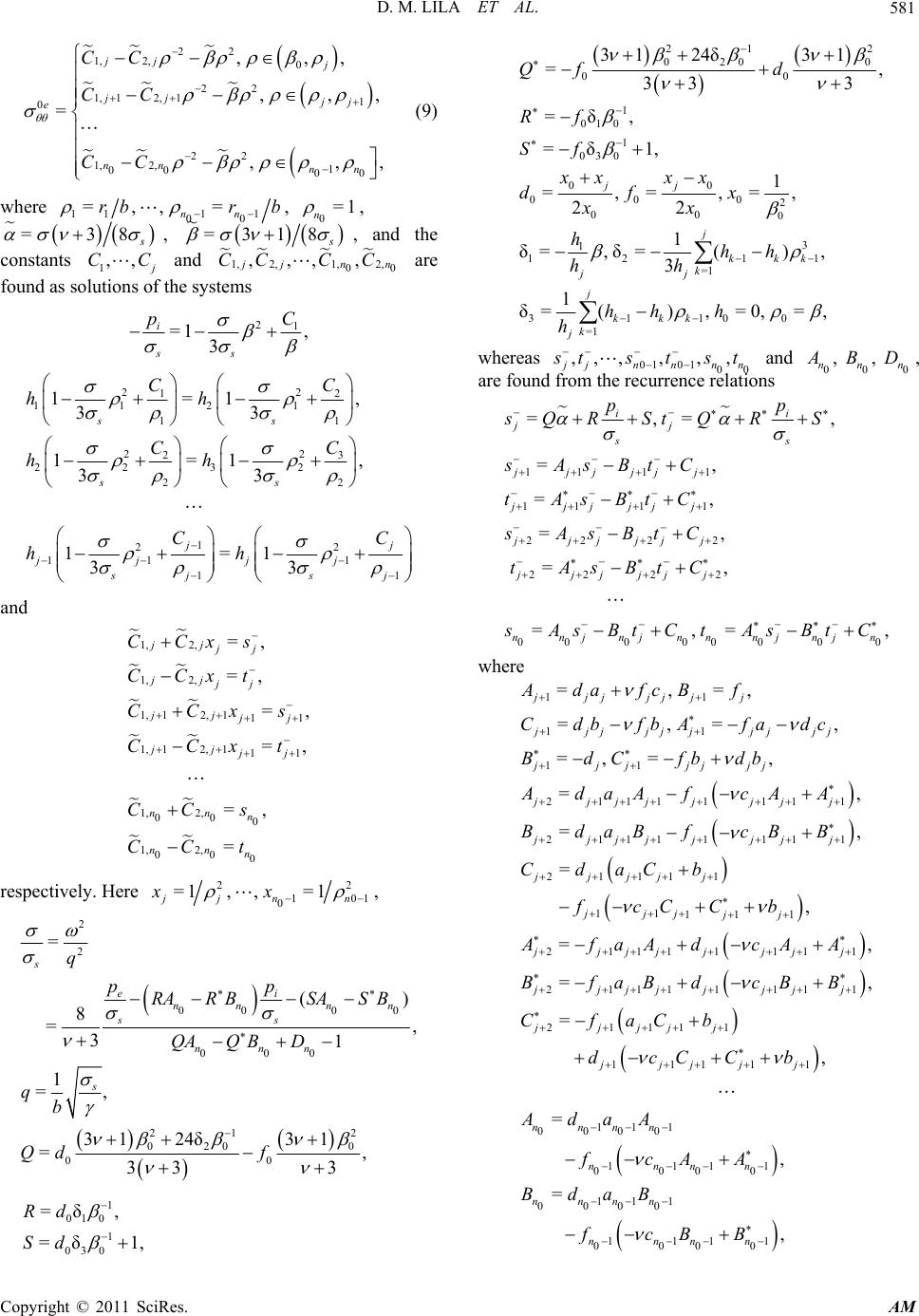 D. М. LILA ET AL.581 , , 22 1, 2,0 22 1, 12, 11 0 22 1, 2,1 00 00 ,,, ,, = ,, jj j jj jj e nn nn CC CC CC (9) where 1111 00 =,,= nn rbrb , 0=1 n , =38 s , =318 s , and the constants 1,, j CC and 1, 2,2, 0 ,,, 1, ,0 j jn Cn CCC are found as solutions of the systems 21 =1 , 3 i ss pC 22 1 11 21 11 22 3 2 2232 22 1 22 11 1 11 1=1, 33 1=1 33 1=1 33 ss ss jj jj jj sj sj CC hh C C hh CC hh 2 , and 1, 2, 1, 2, 1, 12, 111 1, 12, 111 1, 2, 00 0 1, 2, 00 0 =, =, =, =, =, = jj jj jj jj jj jj jj jj nn n nn n CCxs CCxt CCxs CCxt CCs CC t respectively. Here 22 10 0 =1, ,=1 jjn n xx 1 , 2 2 00 00 000 21 2 020 0 00 = () 8 =, 31 1 =, 31 24δ31 =, 33 3 s ei nn nn ss nnn s q pp RAR BSASB QAQ BD qb Qd f 1 01 0 1 03 0 =δ, =δ1, Rd Sd 21 020 0 00 1 01 0 1 03 0 00 000 2 00 0 3 1 12 11 =1 31100 =1 31 24δ31 =, 33 3 =δ, =δ1, 1 =,=,=, 22 1 δ=,δ=(), 3 1 δ=( ),=0,=, jj j kkk k jj j kkk k j Qf d Rf Sf xx xx dfx xx hhh hh hh h h 2 whereas 01 0100 ,, ,,,, j jnnnn s tstst and 0, n A 0, n B0 n D, are found from the recurrence relations 111 1 111 1 222 2 222 2 000 000 =,= , =, =, =, =, =,= ii jj ss jjjjjj jjjjjj jjjjjj jjjjjj nnjnjnnn pp sQRStQ RS sAsBtC tAsBtC sAsBtC tAsBtC sAsBtCt As 00 , j nj n Bt C where 11 11 11 21111111 21111 111 21111 11 =,=, =,= =, =, =, =, = jjjjjjj jjjjjj jjjj jjjjjjj jjjjjjjj jjjjjjjj jjjjj jjj AdafcB f CdbfbAfadc BdCfbdb AdaAf cAA BdaBf cBB CdaCb fcC , 11 1 2111111 2111111 21111 11111 1 00 , =, =, = , = jj jjjjjjjj jjjjjjjj jjjjj jjjjj nn Cb AfaAdcAA BfaBdcBB CfaCb dcCCb Ada 11 00 1111 0000 11 1 0000 1111 0000 , = , nn nnnn nnnn nnnn A fcAA BdaB fcBB 1 1 Copyright © 2011 SciRes. AM  D. М. LILA ET AL. Copyright © 2011 SciRes. AM 582 1111 0000 0 11111 00000 11 111 11 00000000 11 111 11 00000 000 1111 00000 111 000 = , =, =, = nnnn n nnnnn nnnnnnnn nnnnn nnn nnnnn nnnn CdaCb fcCCb AfaAdcAA BfaBd cBB CfaCb dcCC 11 00 0 1 111 1 11111 0 1 11 11 1 1 , =,=1,,, =, = , =2,,, =,=, =,=, 2 =, 2 n kk jjjj jjjj j jjjjj kkk kk kkk kk kk kk kk kk kk k b CDkj n Dgdf DdaD g fcDDg jj n hhh ab hhx hh xx cd hx xx fg x 1 1 0 1 =, =, ,1. kk kk hh hx kj n Dependences (7-9) with account of the relation provide a zeroth approximation to the solution of the problem on plastic equilibrium, determining the position of elastoplastic boundary. In addition, 0=1 p 0 1 00 00 00 0 00 21 d1 =d =3 , =11=3, e ie nn nn s s nn n ee A pp AQBQARB R AS BSC AA where 0 12 00 12 00 3 12 000 0 = 8 3 =, 8 3 0< 1,0<1, 1 =,0,>0,>1, =1, = i s i iein i nn ie e e i nnn es ei p SASB RAR B QAQ BD p n for 0 i , and 3 1 0000 03 1 00 1 0 81 3 == 81 1 3 = e eiennn e se nn is ie RARBSAS B p RAR B p , n 4 0 ,= 1 ij ij a, for . 0 e is the determinant of the matrix The number of sections 0 n of the stepped profile, which approximately substitutes a real one, still remains unknown, and constant half-thicknesses of partial annu- lar discs can be introduced by the average theorem: 0 1 0 0 =d, =,1,, rj j rj j n hyrr ba ba ra jjn n . (11) where (10) where 0 0 0 0 0 0 0 0 11 11 =1,1 , Ins AdE 12 1 1 13 11 14 11 21 21 22 21 23 21 24 21 311,1322,1 =, 1, =,1, =,1, =,1, =,1, =1,1 , =,1, =,=, II n s III ns IV ns Ins II ns III ns IV ns jj a aAd E aAdE aAd E anAd E anAd E anAd E anAd E aq aq First assume that 0 equals to a certain fixed small natural number. Then, with regard to (10), one has a characteristic equation [2-4,7] n 0=0,  D. М. LILA ET AL.583 , , , are the known functions of two vari- 333,1344, 1 415, 1426,1 437,1448, 1 =,= =,= =,= jj jj jj aq aq aq aq aq aq ,, IIV dd ables, and 0 n A , , and 0 n B 0 n C 1, 18,1 ,, j j qq oreover, the critical are tions. Mfound from angular velocity recurrence rela , co 0 rrondingdius esp to the critical ra of the plastic zone , 0,1 nding ins to be seen depe a , is obtained fr on the type of c whether om on-the known form tour load i p, p ulae [7] . It rem , e0 and are exac values for the di t appr with g oxima ven pr tions o ofile f the correspon ding sc i y r. Let be an arbitrary positive number. Let it be con- nected with the absolute error of the stress state, ap- peared due to transition to a stepped disc, by the condi- tion 00 ,,1 0 max sup pe e x ,1 00 0 , , sup sup , zw (12) where the functions (3nd (7)-(9) are taken for 00 = ), (5), (6) a . If for 0 being the solution of charac- teristic equion11), inequality (12) fails, one should take 00 := 1n, redetermine at n ( j h, and also (7)-(9) ac- cording to (10) and solve Equation (1ce1) on again. The fulfillment of condition (12) with new 0 allows to complet solution of the problem on the stability loss of the disc with given profile, with the accuracy of . If equality (12) peated with fails, the descri 1 bed d so on procedure u an. 5. Example Let’s calculate the stability loss for the disc of a hy mst be re- 00 nn:= per- bolic profile =,,>0. s yk ks (13) Many real profiles can be approximately expressed by Equation (13). For such discs, as well as for those of constant thickness (=0s in (13)), the stress-strain state can be obtained in a closed form [9]. From Equality (4), Equation (2) in the plastic region is presented as r 2 d1= s rr . d rr sr rr r b (14) f the corresponding initial problem is of Solution (3) o the following form 2 =21 1 22 11 33 s s s rr i a ra p ss sb or s r sb 2 11 ;,= 13 i ss p xss 12 1 . 13 ss i ss ss 11 p (15) In the elastic region the stress components of the un- perturbed annular disc with a hyperbolic profile can be sought as [9] 2 12 12 2 12 12 12 2 2 =, =11 , rr CrC rr b s CrsC r r b (16) where 1 C, 2 C, 1 , 2 , , ndi are yet to be speci- fied. Substitutionng expressions (16) for of the correspo rr and in equilibrium Equation (14) gives 1 =. 3 s (17) After substitution of expressions (16) into 1 d d1=0,= dd rr rr rmr mm rr , obtained by exclusion of radial displacement coupling equations for deformations and stresses, based on (17), we get from the 31 3 =,=. 831831msm msm mm (18) Busihe method of undetermined coeffiesides, ng t- cients, find the indices 12 , : 2 1,2 =11 . 24 s ss m (19) The condition on the external boundary leads to the relations 12 12 =,=. e CbpCbC C Taking them into account in (16), from the system of stress continuity equations at transition through the elas- toplastic boundary, we get 1 2 01 0 11 = e s p s C 21 20 10 , 11 s s ss (20) Copyright © 2011 SciRes. AM 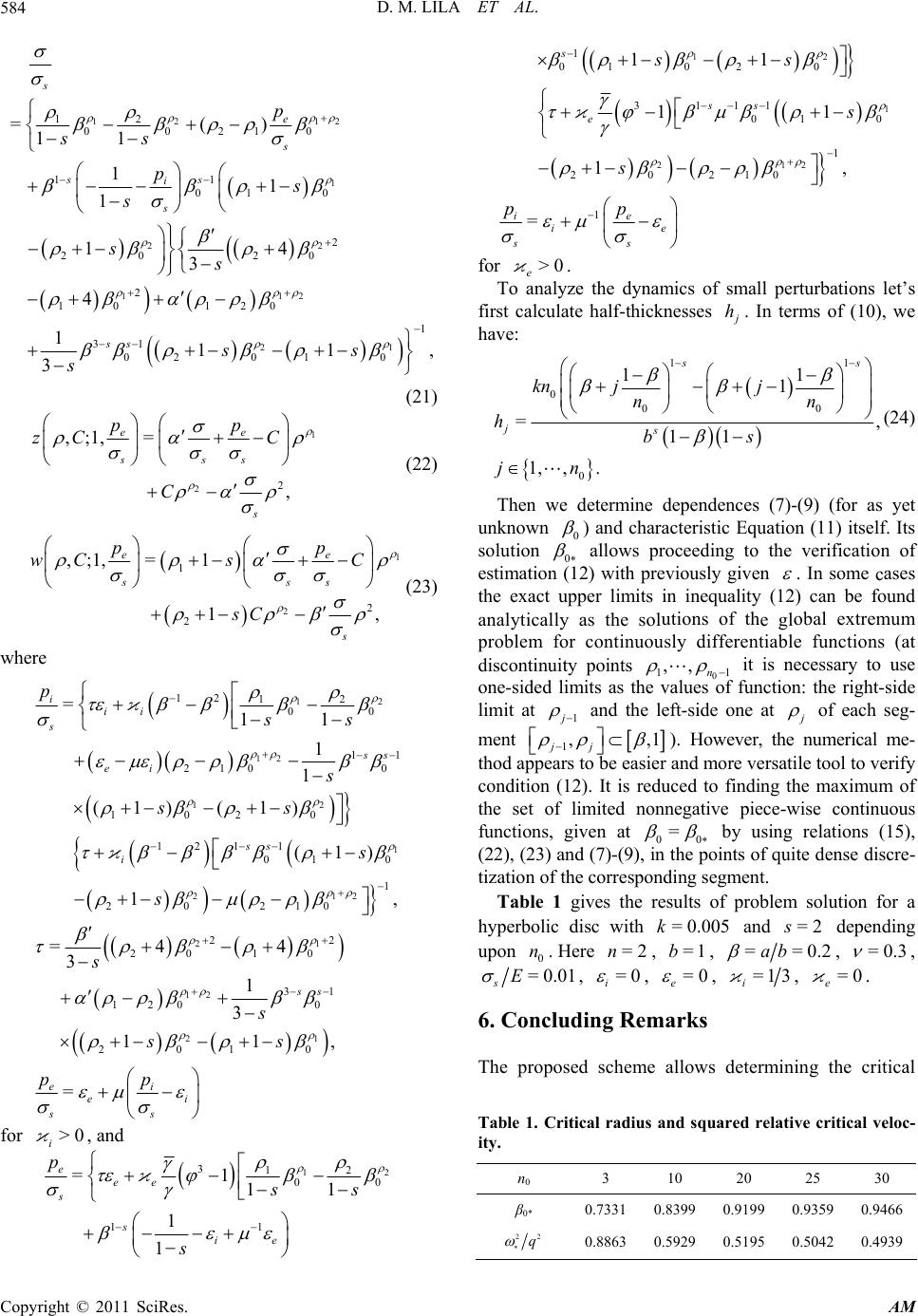 D. М. LILA ET AL. 584 1 11 2 21 11 01 0 2 10 120 1 31 020 10 = 11 1 4 111 3 s s ss i ss ps s ss s 12 12 12 00210 () 11 e p ss 22 2 20 20 14 3 s ss , (21) 1 22 ,;1,= , ee sss s pp zC C C (22) 1 2 1 2 2 ,;1,=1 1, ee sss s pp wCs C sC (23) where 12 12 1 1 212 21 12 12 00 11 210 0 102 0 121 1 01 0 1 20210 22 20 10 1 =11 1 1 (1)( 1) (1) 1, =4 4 3 i ii s 2 s s ei ss i p ss s ss s s s 12 21 31 20 0 2010 1 3 11, = ss ei ei ss s ss pp for , and >0 i 12 312 00 11 =1 11 1 1 e ee s s ie p ss s 12 1 212 1 010 20 3111 01 0 1 20210 1 11 11 1, = s ss e ie ie ss ss s s pp for ze the dynamics of small perturbations let’s first calculate half-thicknesses >0 e . To analy j h. In terms of (10), we have: 11 0 00 0 11 1 =, 11 1, ,. ss js kn jj nn hbs jn (24) hen wrmine dependences (7)-(9) (for as yet unknown Te dete 0 ) and characteristic Equation (11) itself. Its solution 0 allows proceeding to the verification of estimatio with previously given n (12) . In someases the exact upper limits in inequality (12) can be found utions of thobal extremum problem for continuously differentiable functions (at discontin points c analytically as the sol uity e gl 0 11 ,, n he values of it is necessary to use one-sided lits as tfunction: the right-side limit at mi 1 j and thone at e left-side j of each seg- ment 1,, jj 1 ) thod appears to be easier and . However, the numerical m- more versatile tool to verify condition (12). It is reduced to finding the maximum of the set of limited nonnegative piece-wise continuous functions, given at e 00 = ), in the poi by using relations (15), , (23) a (7)-(9nts of quite dense discre- tiz olic disc with and depending upon . Here (22) nd ation of the corresponding segment. Table 1 gives the results of problem solution for a hyperb =0.005k , =1b, =2s 0 n=2n==0ab .2 , =0.3 , =0.01 sE, =0 i , =0 e , =1 3, e i 6. Concluding Remarks The proposed scheme allows determining the critical =0. Table 1. Critical radius and squared relative critical veloc- ity. n0 3 10 20 25 30 β0* 0.73310.8399 0.9199 0.93590.9466 22 q 0.88635195 0.50420.49390.5929 0. Copyright © 2011 SciRes. AM 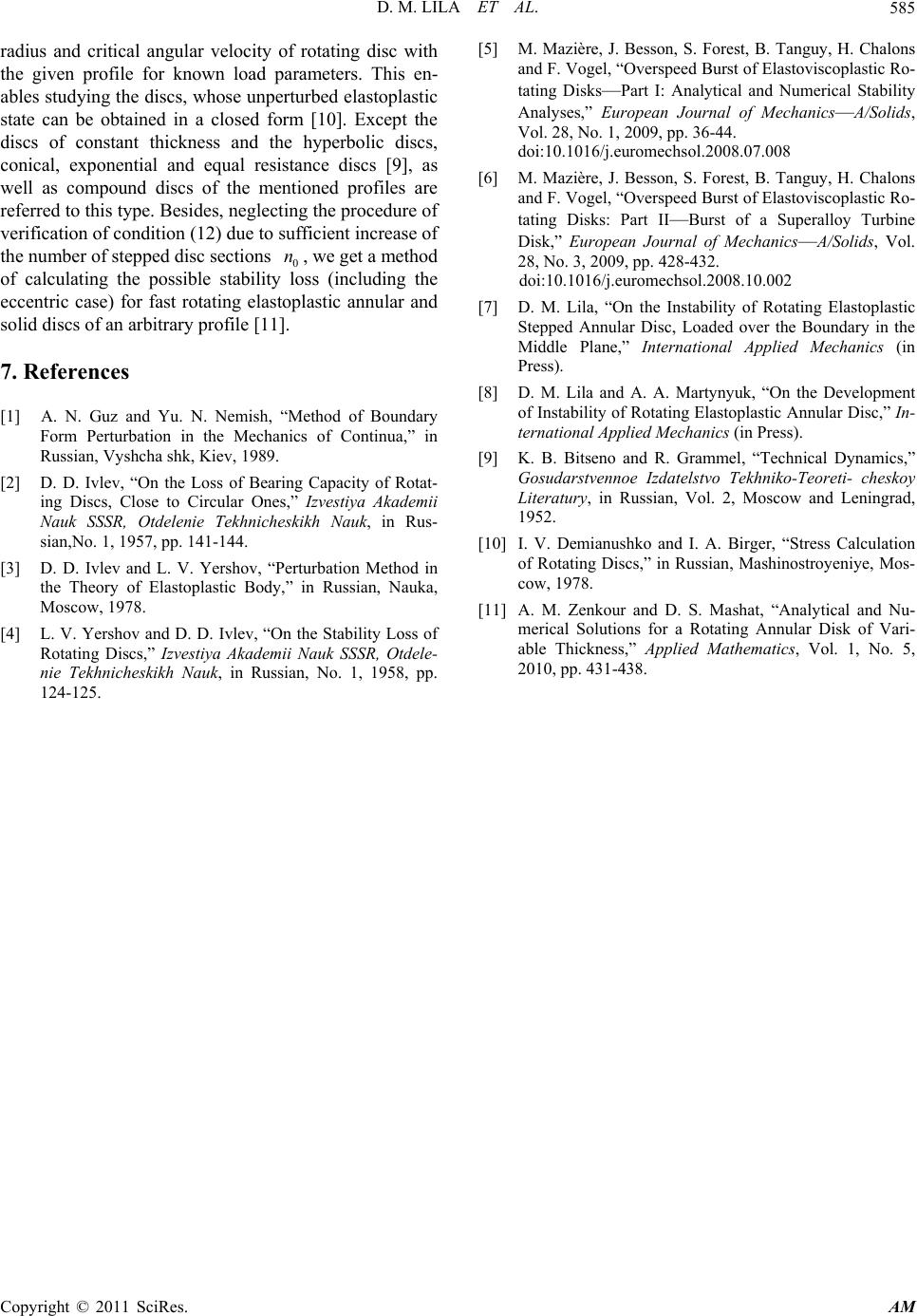 D. М. LILA ET AL. Copyright © 2011 SciRes. AM 585 me tudying the discs, s c annular a isrbitr prof [11]. Russian, Vyshcha shk, Kiev, 1989. ing Discs, Close to Circular Ones,” Izvestiya Akademii Nauk SSSR, Otdelenie Tekhnicheskikh Nauk, in Rus- ,No. 1, 7, pp. 141-144. [3] D. Ivl.shtuMn Theorc Boin Rusan, Nauka Mo ow, lastoviscoplastic Ro- .07.008 t II—Burst of a Superalloy Turbine On the Instability of Rotating Elastoplastic lastic Annular Disc,” In- . irger, “Stress Calculation stroyeniye, Mos- ickness,” Applied Mathematics, Vol. 1, No. 5, [5] M. Mazière, J. Besson, S. Forest, B. Tanguy, H. Chalons and F. Vogel, “Overspeed Burst of E radius and critical angular velocity of rotating disc with the given profile for known load paraters. This en-tating Disks—Part I: Analytical and Numerical Stability Analyses,” European Journal of Mechanics—A/Solids, Vol. 28, No. 1, 2009, pp. 36-44. doi:10.1016/j.euromechsol.2008 ables s whose unperturbed elastoplastic state can be obtained in a closed form [10]. Except the discs of constant thickness and the hyperbolic discs, conical, exponential and equal resistance discs [9], as well as compound dics of the mentioned profiles are referred to this type. Besides, neglecting the procedure of verification of condition (12) due to sufficient increase of th [6] M. Mazière, J. Besson, S. Forest, B. Tanguy, H. Chalons and F. Vogel, “Overspeed Burst of Elastoviscoplastic Ro- tating Disks: Par Disk,” European Journal of Mechanics—A/Solids, Vol. 28, No. 3, 2009, pp. 428-432. doi:10.1016/j.euromechsol.2008.10.002 [7] D. M. Lila, “ e number of stepped disc sections 0 n, we get a method of calculating the possible stability loss (including the eccentric case) for fast rotating elastoplastind solid dcs of an aaryileStepped Annular Disc, Loaded over the Boundary in the Middle Plane,” International Applied Mechanics (in Press). [8] D. M. Lila and А. A. Martynyuk, “On the Development of Instability of Rotating Elastop ternational Applied Mechanics (in Press) 7. References [1] А. N. Guz and Yu. N. Nemish, “Method of Boundary Form Perturbation in the Mechanics of Continua,” in [2] D. D. Ivlev, “On the Loss of Bearing Capacity of Rotat- [9] sian 195 D. the ev and L y of Elas V. Yer toplasti ov, “Per dy,” rbation si ethod i , co K. B. Bitseno and R. Grammel, “Technical Dynamics,” Gosudarstvennoe Izdatelstvo Tekhniko-Teoreti- cheskoy Literatury, in Russian, Vol. 2, Moscow and Leningrad, 1952. [10] I. V. Demianushko and I. A. B of Rotating Discs,” in Russian, Mashino w, 1978. [11] A. M. Zenkour and D. S. Mashat, “Analytical and Nu- merical Solutions for a Rotating Annular Disk of Vari- able Th sc 1978. [4] L. V. Yershov and D. D. Ivlev, “On the Stability Loss of Rotating Discs,” Izvestiya Akademii Nauk SSSR, Otdele- nie Tekhnicheskikh Nauk, in Russian, No. 1, 1958, pp. 124-125. 2010, pp. 431-438. |

